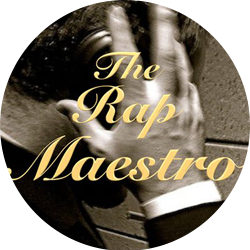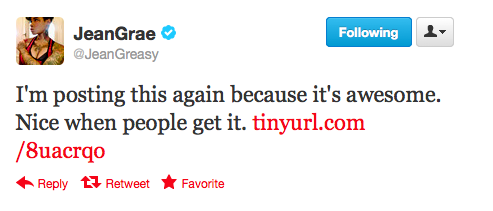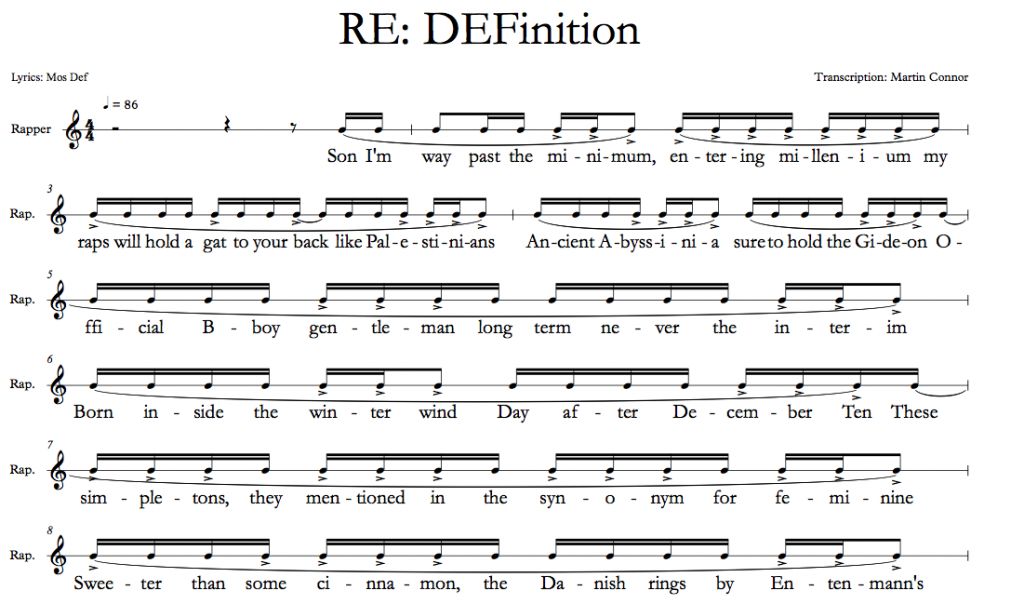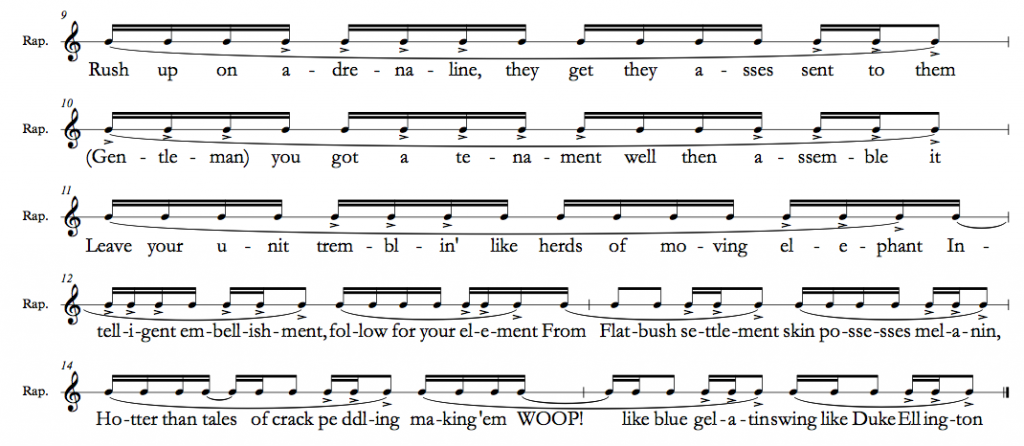Time for another analysis. This one goes out to all my new followers on Twitter, as well as Jean Grae, who showed me some love for the analysis I tweeted at her. It’s now on her bio! Check out, @JeanGreasy. It’s honestly too good to be true, this doesn’t seem real – my link on her twitter below…
but moving on.
Now, I’ve been doing these analyses for a bit of a while now…I think the first one goes back to January. And over this time, I’ve chosen many different rappers for us to take a look at. In order, Game’s “How We Do”, then Eminem, Nas, Dr. Dre’s rap as ghost-written by Obie Trice (with his opening verse on “Shit Hits The Fan”, Time Bomb (who?) and Kanye West (his production) here, Dr. Dre’s production on Busta Rhymes’ song “Oh!”, Jean Grae, Common’s “I Used To Love H.E.R.”, MC Napkins’s “The Aggressive Bee”, and, most recently, Dre again, with a look at his orchestration in his songs from 2000-2009.. Over this time, and as I made clear at the end of the Jean Grae post, I look, listen to, and like a very specific type of rapper: they are, as a general, very vague description, technically complex. TECHNICALLY COMPLEX! WHAT DOES IT MEAN?!?!?!
Well, the technically complex rapper will have a high rate of accents per note, will have a wide array of techniques at their disposal in their rapper “toolbox” (musical phrases, metrical transference of those phrases, through-composed form, syntactical phrase manipulation, and more), and will executive fairly complex rhymes (block rhymes, multisyllabic rhymes, and so on.) (An accent, for our purposes here, will basically be considered a rhyme. It is my theory that any syllable on a note that rhymes with another one sticks out in the listener’s ear and can thus be considered an accent, which is indicated below on the musical transcription by the mathematical less than sign, such as those on the notes and syllables of the word “minimum” in bar 2. A rapper’s flow is thus able to be very well described by where they place the accents in the bar – at the end of a line, or in the middle of a line, or always/never/sometimes in the same parallel musical position from bar to bar – for instance, always on beat 3, and more. For more discussion of these concepts, see my other analyses. In order to avoid being even more redundant, that’s all I’ll say about it for now.)
And over this time, we’ve gotten to look at a lot of great rappers. However, some have been unfortunately, almost criminally (okay, definitely criminally), overlooked. These include Black Thought of The Roots, Eminem (who didn’t get the look he should’ve), Busta Rhymes, Mos Def, and Talib Kweli. Well, today, I rectify at least one of those cases. Today we take a look at Mos Def.
This time, we’ll be looking at the song “RE: DEFinition”, from the debut, self-titled Blackstar (Talib Kweli + Mos Def) album. (Apparently they’re coming out with a new one soon, look for it.) You can hear the song on youtube here. The section of the verse we’ll take a look at starts at 1:46 and ends at 2:24 about. Take a listen, and look at the musical transcription of the verse all the way down at the bottom of this post.
First, let’s do the numbers. In the part of the verse I’ve transcribed below, there are 202 notes. Of those notes, 104 of them are accented (again, roughly equivalent to “rhymed.”) This means that, over 14 bars, a little over 51% of notes are accented. Furthermore, this means that, over these 14 bars, 7.4 16th notes per bar (out of a total 16 16th notes per bar) are accented. If we compare this to other rates we’ve seen, it ranks very high up there due to its long duration. Jean Grae, over the length of a decidedly shorter 6 bars (when compared to Mos’ 14), packs in about 75% to 85% of all notes as being accented, with rates of about 8.4 to 12 16th note accents per bar. Eminem, in what is admittedly not his best work, at one point in the song “Business” (click the link for my analysis of it) writes in about 4.5 accents per. So Mos’ work already compares favorably. But I believe it is the manner in which Mos Def executes these accents which makes it even more remarkable. Eminem, for instance, made all of his accents off a very common vowel sound: “-ee” – “Emcee”, “breathes”, “free-ly”, and so on. I term this type of rhyming, off a single vowel sound, iso-syllabic rhyming (“one syllable.”) Mos’ work, meanwhile, should be termed multi-syllabic block rhyming. Multi-syllabic, because each word he rhymes is made of more than 1 syllable: minimum, entering, millennium, and so on. Block rhyming, because he is consistently rhymes the same vowel sounds in the same, or very nearly the same order.
Let’s take a look at this block rhyme. An archetype for the vowel sounds in this block occurs with word “interim.” The syllables are, thus, “in-“, “-ter-“, and “-im.” The vowel sounds, there, are “-ih-“ (like the vowel sound in “pit”), “-uh-“ (like “cut”), and “-ih-“ again (again, like “pit.”) It is important to note here the great importance that the manner of pronunciation for a word matters very greatly in rap as to whether a word is rhymed or not. For instance, the word “interim” “should” (according to dictionaries or whatever) be pronounced with the vowel sounds “-ih-“, “-er-“, and “-ih-.” Mos, however, substitutes the “-uh-“ sound for the “correct” “-er-“ sound. If he hadn’t, it wouldn’t have rhymed as well with the following block (this time, made of multiple words,) “winter wind.” That block, “winter wind”, is again pronounced with an alteration: it is “win-tuh” wind, not “win-ter wind” (with an “-er-“ like in the word nerd.) (The changing between a multi-word block and a single-word block is the reason I refer to a rhymed block, rather than a rhymed word.)
Thus, these “-ih-“, “-uh-“, and “-ih-“ sounds are rhymed, over and over, in consecutive metrical positions (they are all next to each other in the music.) This is a list of all the iterations of this block, with the original word divided into its syllables and the vowel sounds indented on the next line:
mi-ni-mum
ih uh uh
en-ter-ing
eh er ih
mi-lle-ni-um
uh eh ee uh
Pal-e-sti-ni-ans
ah uh ih ee ih
A-byss-in-i-a
ah uh ih ee ih
Gi-de-on
ih ee uh
Gen-tle-man
eh uh in
In-ter-im
ih uh ih
Win-ter wind
ih uh ih
De-cem-ber Ten
ih im uh ih
Sim-ple-tons
ih uh ih
Men-tioned in
ih uh ih
Syn-o-nym
ih uh ih
Fe-mi-nine
ih uh ih
Ci-nna-mon
ih uh ih
En-te-nmann’s
eh uh ih
A-dre-na-line
uh eh ih uh ih
Sent to them
eh uh ih
Gen-tle-man
eh uh ih
A ten-a-ment
eh uh ih
A-ssem-ble it
eh uh ih
Trem-bl-ing
eh uh ih
E-le-phant
eh uh ih
In-tell-i-gent
ih eh uh ih
Em-bell-ish-ment
eh eh ih ih
E-le-ment
eh uh ih
Sett-le-ment
eh uh ih
Mel-a-nin
eh uh ih
Pe-ddl-ing
eh uh ih
Gela-t-in
eh uh ih
Ell-ing-ton
eh uh ih
Now, you might notice some aberrations. For instance, at one point, the initial “-ih-“ sound becomes an “-eh-“ sound, such as at “emBELlishment.” This then continues for the rest of the song. However, since it is still so similar to the archetypal block we’ve identified, I consider it simply a variation of what came first. Then, before we reach the word “interim”, there is some further variation in the vowel scheme of the block. At times, the block seems to be 4 or 5 syllables long (“Palestinian”, “Abyssinian”), and seems to have other vowel sounds in it in different places in the block (“entering”, with the sounds “-eh-“ “-er-“ and “-ih-.”) Again, these just seem to be variations of the block that appears with “interim.” They all still use the same sounds, just in different orders, or they use vowel sounds that are very similar to those in the block. For instance, sometimes the difference between the pronunciation of the “-ih-“ sound and “-eh-“ sound are so close that they sound the same. Thus, I’ve accented them all.
There are 31 iterations of this block over 14 bars, meaning there are 2.2 blocks per bar. The block is 3 syllables long, equivalent to 3 16th notes, and 2.2 x 3 = 6.4. This means that 6.4 out of the 16 16th notes in a bar of music with the time signature 4/4, as this song has, is already dedicated to being used in that one block rhyme scheme. This is pretty amazing. I will quote directly from my Jean Grae analysis, adding Mos Def’s name instead, to explain why:
———————————
When one chooses a word to rhyme off of, one immediately and by necessity restricts the number of different things one can say. For instance, if you say, “I’m the best rapper ever”, you’ve already limited yourself to saying things that only end in rhymes with “ever,” or “best”, or “rapper,” and so on.
Or so you’d think.
Because this limitation doesn’t seem to exist for Mos Def. He seems to always locate the exact words with the maximum amount of accents to say what she’s trying to say. There are an infinite amount of ways to express the same idea as “Son I’m way beyond the minimum”, but he comes up with a way that fits in an incredible amount of accents. The entwining between what he wants to express and the exact words he uses is flawless. It should be very, very clear that this is not true for all rappers.
I hate to pick on him, because usually I like what he does, but let’s consider a rhyme from Busta Rhymes that displays the limitation we were just previously discussing. In “Get You Some”, again from “The Big Bang” (just like the song “Don’t Get Carried Away” that we analyzed”), Busta begins the following verse like so: (no sheet music transcription is necessary, because we’re concerned only with his words)
“A lot of niggas shit sounds dated /
I’m like Shaq, the franchise player just got traded /
To the number one team in the league, I ain’t on
Jay records, I’m on Dre records, Aftermath bitch!”
If you look at this whole rhyme, what I said before starts to make sense. It’s pretty easy to see that the main idea of the rhyme, the purpose of the rhyme, is to express how Busta feels about leaving one record label for another. Busta started with the idea that he wanted to talk about that. With that, he started with what could be called the “hook” of the rhyme, what he started with: that he (Busta) is like Shaq, who left the Orlando Magic for the very good LA Lakers, just like Busta left Jay records for the industry leading Aftermath Records. The first line Busta started writing these 4 lines with was “I’m like Shaq, the franchise player just got traded.” We know this because the first line of the rap is only extremely tangentially related to the topic at hand that Busta is discussing. He says, “A lot of niggas shit sounds dated.” Excuse me, but what the hell does that have to do with Busta leaving Jay records for Aftermath? Unfortunately, nothing. We can see that all of the verbal material is not tightly related. It comes in bits and pieces. He started with the line “I’m like Shaq, the franchise player just got traded,” then looked around for anything that rhymes with the word “traded.” He found dated and made the line given above. Furthermore, I have also included what comes in the lines after just to show that Busta doesn’t return to the “a lot of niggas shit sounds dated” idea as well.
Again, I regret mentioning Busta in a negative context. This might not be the most glaring example, but it illustrates what we were talking about before from the opposite point of view. Busta immediately limited his options when he started with the line “I’m like Shaq, the franchise player just got traded,” and then worked from there. This exact thing just doesn’t seem to happen for Mos Def. All of his lines in these examples are related, they all lead clearly in their ideas from one to the other, and they always make sense.
End Quote———————–
Furthermore, Mos varies his placement of his block and his accents in the bar. In bar 2, the block, “minimum”, occurs on beat 2, then beat 3 (“entering”), then beat 4 (“millennium”), then on beat 4 in bar 3 (Palestinians), on beat 2 in bar 3 (Abyssinia,) and so on. From bar to bar, one could never predict in advance quite where Mos is going to put the block rhyme in the bar. Finally, let’s consider the length of his words. There are 202 syllables in these 14 bars, and 118 words. This means that each word is about 1.71 syllables. Anyone who has ever tried to rap knows that longer words are harder to fit into raps. Let’s compare Mos’ rate of 1.71 syllables to other rappers, such as what we saw in the Nas analysis: in Nas’ “Don’t Get Carried Away”, he was at 1.48 syllables per word. Eminem, in the “Business” excerpt, was at 1.21 syllables per word, and Game in “How We Do” was at 1.19. Meanwhile, Mos is at 1.71, 15.5% longer words than the next closer rapper, Nas. Damn.
So, as we’ve seen, Mos is a pretty technically complex rapper. The hallmarks of his style here are the extended block rhyming, the high number of accents per bar, the complex rhymes, and the changing of the accents’ metrics.
Hope you enjoyed it! Check out my other posts if you did, and send me an email at [email protected] if you want!
If you liked this article, you might enjoy these other ones, which are among my most popular:
1.) An analysis of Nas’ flow on the 2006 Busta Rhymes song “Don’t Get Carried Away,” which you can read here.
2.) My album review & analysis of the 2012 Kendrick Lamar album “good kid, m.A.A.d city,” which you can read here.
3.) A database of who the 23 most repetitive rappers in the industry are, available here.
4.) A study of every instrument Dr. Dre used on his songs between the years 2000 and 2009, online here.
5.) A breakdown of Eminem’s song “Business,” which you can check out here.






Amazing analysis. I'm looking forward to reading your book when you decide to write it.
Just saw this – thanks a lot! I'll let you know!